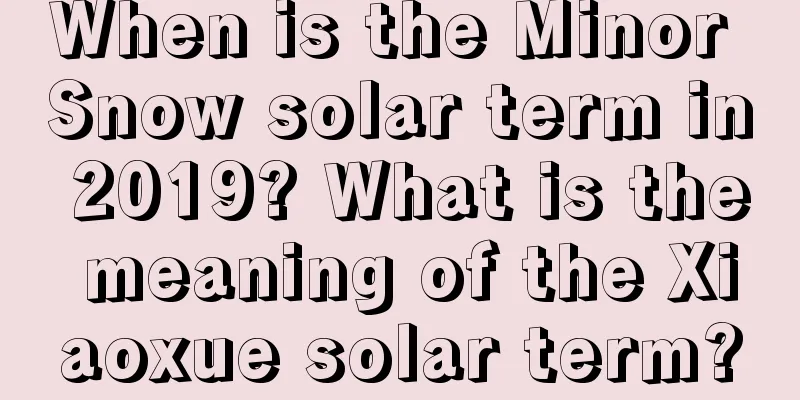When is the Minor Snow solar term in 2019? What is the meaning of the Xiaoxue solar term?

Xiaoxue is the 20th of the 24 solar terms. "Collected Explanations of the 72 Seasonal Changes" says: "In the middle of October, the rain falls but is thinned by the cold air, so it condenses into snow. The "minor snow" means not yet heavy." The reason why "minor snow" is called "minor snow" is relative to the "great snow" solar term. The ancients said: "great snow" means heavy, and at this point the snow is heavy. This judgment of the ancients is not very scientific. It cannot be generalized in different regions and years. The snowfall in the Minor Snow solar term is not necessarily smaller than that in the Heavy Snow solar term. When is the Minor Snow solar term in 2019? What is the meaning of the Xiaoxue solar term? Everything you want to know is here. In the tenth month of the lunar calendar, the weather starts to get cold, and winter has already arrived. Pay attention to Mr. Shui Mo’s special feature on October of the lunar calendar in 2019, and enjoy this beautiful October together.When is the Minor Snow solar term in 2019?The date of Xiaoxue in 2019 is: Friday, November 22, 2019. Lunar calendar: October 26. Xiaoxue, in the 24 solar terms, indicates the starting time and degree of snowfall. Entering the Xiaoxue solar term means that the temperature continues to drop and snowy weather begins to appear. The snow at this time is in a semi-frozen and semi-melted state, also known as "wet snow" or "sleet". Xiaoxue is the 20th of the 24 solar terms. On November 22 or 23, the sun reaches 240° of ecliptic longitude, which is called the Minor Snow solar term. At this time, the sun is at declination -20°16'. The daylight time in Beijing is only 9 hours and 49 minutes, and the sun's altitude at noon is only 29°50'. During the "Xiaoxue" solar term, the handle of the Big Dipper points to northwest at night (equivalent to 10 o'clock on the clock face). If you go outdoors to stargaze after 20:00 every night, you can see the Big Dipper sinking in the west, while the "W"-shaped Cassiopeia rises high in the sky. It takes the place of the Big Dipper to take on the task of finding the coordinates of the North Star and provide navigation for stargazers. The quadrilateral Pegasus is right in the sky, and the symbol of the winter sky, Orion, has already peeked out over the eastern horizon. During this solar term, northwest winds start to become frequent in vast areas of China, and the temperature drops, gradually falling below 0℃. However, the earth is not yet too cold, and although it begins to snow, the amount of snow is not large, so it is called Light Snow. At this time, the yin energy decreases and the yang energy increases, causing the heaven and earth to be blocked, yin and yang to be out of communication, all things to lose their vitality, the heaven and earth are closed and the severe winter begins. The first snow will appear in areas north of the Yellow River, reminding people to keep warm. What is the meaning of the Xiaoxue solar term?The "Collection of Explanations of the 72 Lunar Calendars" says: Light Snow: In mid-October, the rain falls but is thinned by the cold air, so it condenses into snow. A word for small things that are not yet full. The Minor Snow solar term is the middle of the tenth month in the lunar calendar. At this time, the rain condenses into snow due to the cold, and the amount of snow is not large, so it is called Minor Snow. The ancients' statement that "rain condenses into snow" is inaccurate. Snow is ice crystals formed by the direct condensation of water vapor in the air at temperatures below 0°C, and it is not condensed from rain. However, this wrong statement reflects the true state of the ancients: the reason why they used condensed rain to explain snow was because they were very concerned about the relationship between rain and snow and the transition between rain and snow. In the "Da Dai Li Ji" Zengzi Tianyuan, it says: When Yang energy prevails, it dissipates as rain and dew; when Yin energy prevails, it condenses into frost and snow. In the eyes of the ancients, rain, dew, frost and snow are all products of the harmonious integration of yin and yang. When yang is stronger than yin, rain and dew are formed, and when yin is stronger than yang, frost and snow are formed. This view has a certain scientific basis. |
<<: What activities can be organized during the Minor Snow solar term?
>>: What is the lucky star for people born in the Chen hour during the winter solstice in 2019?
Recommend
What are the do's and don'ts on the 14th day of the 11th lunar month in 2017?
In the eleventh month of the lunar calendar, whet...
Which zodiac sign is in conflict with the Double Ninth Festival in 2021? Is it an auspicious day?
The zodiac signs that clash at different times are...
What is the lunar calendar for November 30th, 2018? Is it an auspicious day?
The custom of "selecting an auspicious day&qu...
Where is the direction of the God of Happiness on the fourth day of the eighth lunar month in 2020? In what direction?
The eighth month of the lunar calendar is Mid-Aut...
Can construction start on July 13th of the lunar calendar in 2022? What is the procedure for the groundbreaking ceremony?
The seventh month of the lunar calendar has arrive...
What is the meaning of Jingzhe? What are the customs of Jingzhe?
The 24 solar terms are the crystallization of the ...
When is the Minor Cold in 2022? How to read the time of Minor Cold? Is the time of Xiaohan fixed?
Lesser Cold and Greater Cold are the two coldest s...
When is Cold Dew in 2021? What month, day and week is it?
As one of the 24 solar terms, the Cold Dew solar t...
Query the location of the God of Wealth on April 7, 2019
The fourth month of the lunar calendar has quietl...
What is the zodiac sign of a child born on the seventh day of the seventh month of the lunar calendar in 2020 (Qixi Festival)?
The zodiac signs of children born at different tim...
What is the month, day, time and minute of the Spring Equinox in 2021? The specific time of the Spring Equinox
Although everyone is familiar with the Spring Equi...
Is July 9, 2019 a good day to open a new store?
Not every day is suitable for opening a business....
Is it okay to offer sacrifices on the 30th day of the seventh lunar month in 2018? Who are the objects of the sacrifices?
Offering sacrifices to the gods comes at the cost ...
Is the second day of the twelfth lunar month in 2020 an auspicious day for signing a contract?
Is the second day of the twelfth lunar month in 20...
What is the fate of a girl born in Guyu year in 2021? Is she lucky?
When duckweed begins to grow, Grain Rain arrives. ...









